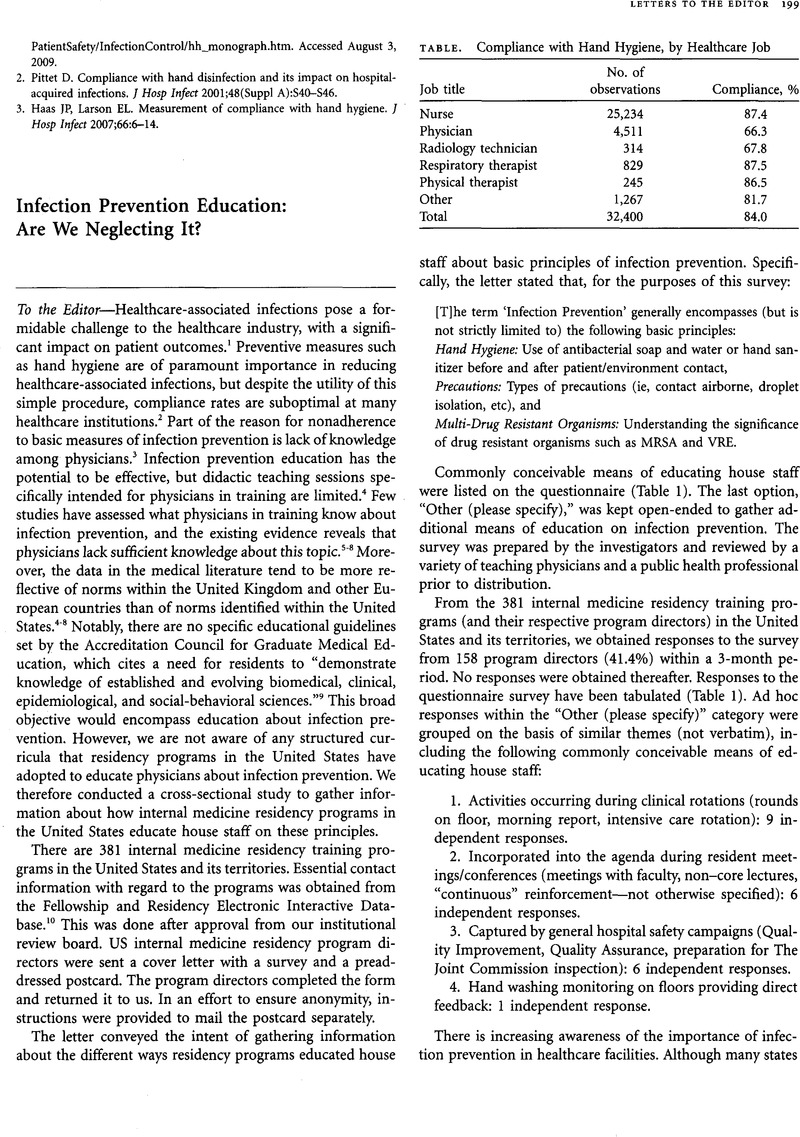No CrossRef data available.
Article contents
Infection Prevention Education: Are We Neglecting It?
Published online by Cambridge University Press: 02 January 2015
Abstract
An abstract is not available for this content so a preview has been provided. As you have access to this content, a full PDF is available via the ‘Save PDF’ action button.

- Type
- Letters to the Editor
- Information
- Copyright
- Copyright © The Society for Healthcare Epidemiology of America 2010
References
1.Klevens, RM, Edwards, JR, Richards, CL Jr, et al.Estimating health care-associated infections and deaths in U.S. hospitals, 2002. Public Health Rep 2007;122:160–166.Google Scholar
2.Boyce, JM, Pittet, D. Guideline for hand hygiene in health-care settings: recommendations of the Healthcare Infection Control Practices Advisory Committee and the HICPAC/SHEA/APIC/IDSA Hand Hygiene Task Force. Infect Control Hosp Epidemiol 2002;23(121 suppl):S3–S40.Google Scholar
3.Erasmus, V, Brouwer, W, van Beeck, EF, et al.A qualitative exploration of reasons for poor hand hygiene among hospital workers: lack of positive role models and of convincing evidence that hand hygiene prevents cross-infection. Infect Control Hosp Epidemiol 2009;30:415–419.Google Scholar
4.Farrington, M. Infection control education: how to make an impact-tools for the job. J Hosp Infect 2007;65(suppl 2):128–132.Google Scholar
5.Mann, CM, Wood, A. How much do medical students know about infection control? J Hosp Infect 2006;64:366–370.CrossRefGoogle ScholarPubMed
6.Sax, H, Perneger, T, Hugonnet, S, Herrault, P, Chraïti, MN, Pittet, D. Knowledge of standard and isolation precautions in a large teaching hospital. Infect Control Hosp Epidemiol 2005;26:298–304.Google Scholar
7.Brady, RR, McDermott, C, Gibb, AP, Paterson-Brown, S. Fact or infection: do surgical trainees know enough about infection control? Ann R Coll Surg Engl 2008;90:647–650.CrossRefGoogle ScholarPubMed
8.Tavolacci, MP, Ladner, J, Bailly, L, Merle, V, Pitrou, I, Czernichow, P. Prevention of nosocomial infection and standard precautions: knowledge and source of information among healthcare students. Infect Control Hosp Epidemiol 2008;29:642–647.CrossRefGoogle ScholarPubMed
9.Accreditation Council for Graduate Medical Education (ACGME). Program director guide to the common program requirements. IV. Education program. http://www.acgme.org/acWebsite/navPages/commonpr_documents/IVA5b_EducationalProgram_ACGMECom petencies_MedicalKnowledge_Documentation.pdf. Accessed July 26, 2009.Google Scholar
10.American Medical Association (AMA). FRIEDA online, http://www.ama -assn.org/ama/pub/education-careers/graduate-medical-education/freida -online.shtml. Accessed February 2, 2009.Google Scholar




